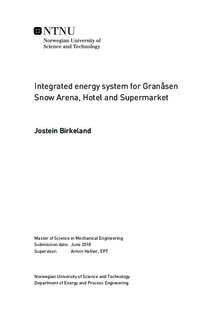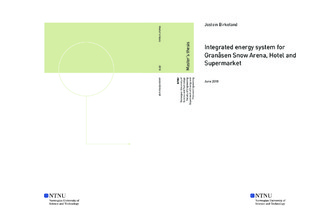| dc.description.abstract | Granåsen in Trondheim is the chosen location for Norway s application to host the 2023 FIS Nordic Ski World Championships. One of the investments to develop the area around Granåsen is a new building accommodating a REMA1000 supermarket and a 200 room hotel. A key feature for the hotel is to offer its guests a cross-country slope available all year. This thesis aims to describe how a centralized heat pumping unit should be designed to provide all major thermal demands of the building in addition for the snow production to the cross-country slope.
The snow demand of the cross-country slope with and without provided shade is calculated using a degree-day method which includes radiation. Meteorological data is collected from the database Meteonorm. A model of the hotel is created in the building simulation software SIMIEN, to obtain heating and cooling demands. A numerical model of the centralized R744 heat pump integrated with a flake ice machine is created in Microsoft Excel, utilizing the free library RnLib for thermodynamic data. Four cases are defined to investigate costs and performance. In cases 1 and 2, all available heat is recovered. In cases 3 and 4, heat is only recovered to cover the demand of the building. In cases 1 and 3, snow is produced continuously, whereas in cases 2 and 4, snow is produced during the hours of the day with cheaper electricity.
In annual simulations, shading was found to reduce the snow demand from 80 406 m$^3$ to 47 036 m$^3$. The required snow storage volume to overcome the snow demand in summer is 20 000 m$^3$. The annual average energy efficiency of the heat pump was found to be 4.62, with 8 times more heat available in the gas cooler than the demand of the building. Sale of the excess heat to local clients is therefore considered. A 30 m$^3$ thermal storage tank is required to cover the heating demand. Parameter studies altering the high-side pressure and evaporation temperature in the flake ice machine were carried out and found to increase the efficiency from 4.62 to 5.02 and 5.79, respectively. This is higher than traditional heat pumps and similar to existing R744 systems. The current design should be improved by reducing the high-side pressure, in accordance with the findings of the parameter study. The results also suggest that one-stage compression of the discharge from the flake ice machine, especially in combination with a higher evaporation temperature in the flake ice machine, will improve performance. The sale of excess energy will cover a large part of the electricity cost and greatly increase the profitability of the investment. | |

